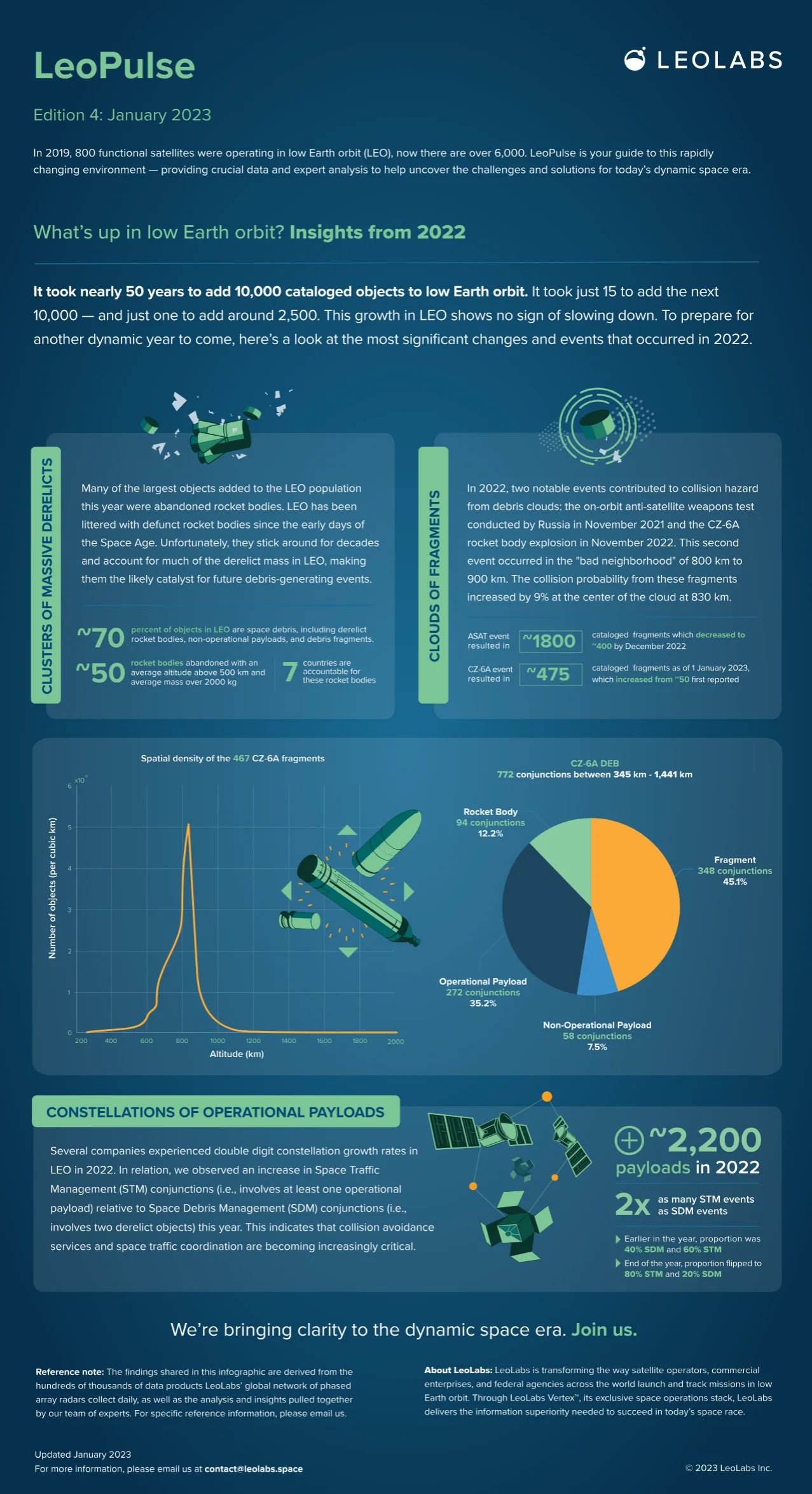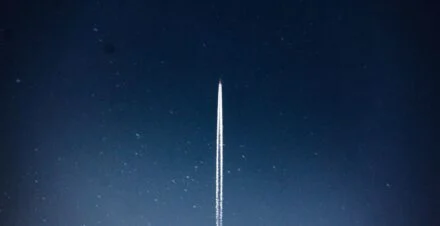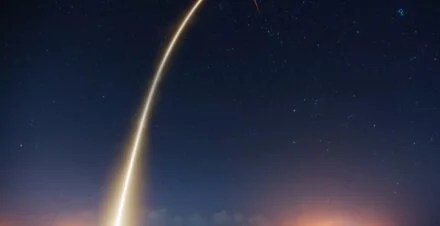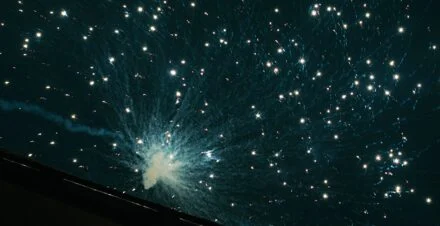Short on time? Listen to this article on-the-go.

Low Earth orbit is a dynamic environment.
In 2007, the number of cataloged objects in LEO crossed the 10,000-object mark. It took nearly 50 years, since the dawn of the Space Age, to add those 10,000 objects. That’s about 200 objects a year on average. Contrast that with late 2021, when the 20,000-object mark was crossed. This time, it took roughly 15 years to amass an additional 10,000 objects. That’s about 650+ objects a year.
Contrast that again with 2022, when the number of objects in LEO increased by ~2,500 (or 13%) to a total of ~21,000. While operational payloads accounted for most of this growth, ~70% of objects in LEO are still space debris. This includes intact derelict rocket bodies and nonoperational payloads, as well as fragments from hundreds of dead satellites.
“This growth in LEO shows no sign of slowing down. While exciting, we must be aware of and prepare for the challenges to come.”
This growth in LEO shows no sign of slowing down. While exciting, we must be aware of and prepare for the challenges to come. To do that, we’re using this special edition of LeoPulse to provide key data points and insights on the most significant changes and events that occurred in 2022. Our hope is that this annual review will provide crucial context for the new year, one which promises to be even more dynamic than the year past.

From the ground up: an in-depth look at the traffic in LEO through the year 2022
Before we dive in, here’s a reminder of how we categorize our insights. (Read our first review for a more detailed explanation.)
The LEO population consists of three primary components: “Clusters” of massive derelicts, “Clouds” of fragments, and “Constellations” of operational payloads. Each of these components exhibited interesting collision risk patterns in 2022. Using the depth of data collected by our growing global network of phased array radars, we’re going to “demystify” these patterns for you, delving into each and highlighting notable events.
— Skip to: Clusters | Clouds | Constellations —

Clusters of massive derelicts
Many of the largest objects added to the LEO population this year were abandoned rocket bodies. This isn’t new. LEO has been littered with defunct rocket bodies since the early days of the Space Age. It is, however, still consequential. Why? Because these rocket bodies stick around for decades. In fact, the rocket body from the seventh space launch ever, Vanguard 2 in 1959, is still in LEO today… more than 64 years later.
In 2022, ~50 rocket bodies were abandoned in LEO above an average altitude of 500 km with an average mass of over 2,000 kg. (That’s 150+ times more massive than a 6U CubeSat!) Seven countries account for these abandoned rocket bodies, including every major spacefaring entity except the European Space Agency. More than a third of these rocket bodies originated from China (two are currently in the “bad neighborhood” of 800 to 900 km). It should be noted that there were an additional 24 rocket bodies deposited in higher orbits outside of LEO. These typically stay in orbit even longer.
“LEO has been littered with defunct rocket bodies since the early days of the Space Age. It is, however, still consequential. Why? Because these rocket bodies stick around for decades.”
The “bad neighborhood” referenced above (and in our previous reports), is where many massive derelicts were historically abandoned. This region, 800 to 900 km, continues to be a hot spot for debris collision risk. In 2022, for example, there were 836 conjunctions in LEO with a miss distance less than 100 meters; nearly a third of these most dangerous conjunctions — 237 instances — occurred in this neighborhood.
Key takeaways:
- In 2022, ~50 rocket bodies were abandoned by seven countries above 500 km average altitude with an average mass of over 2,000 kg
- The “bad neighborhood” of 800 to 900 km continues to be a hot spot for debris collision risk: 1/3rd of the most dangerous conjunctions in LEO occurred here

Clouds of fragments
In early 2022, we observed a rapid rise of cataloged fragments resulting from the on-orbit anti-satellite weapons (ASAT) test conducted by Russia in November 2021. This event, which destroyed the Cosmos 1408 (C1408) payload, eventually resulted in over ~1,800 total cataloged fragments, but never more than ~1,200 at once. This number peaked in March 2022 and dwindled to ~400 by December 2022, due to atmospheric drag. Interestingly, despite the rapid decline of the number of fragments in the catalog, the number of Conjunction Data Messages (CDMs) issued involving a fragment from the C1408 breakup did not follow the same trend. This was partially due to the increased number of operational satellites deployed in 2022 that were characteristically threatened by C1408 fragments.
Unfortunately, just as the C1408 fragment cloud was being cleansed from LEO, the Chinese CZ-6A rocket body exploded. This event occurred on 12 November 2022, soon after it deployed the Yunhai 3 weather satellite into an 854/856 km orbit, which is in the “bad neighborhood” we mentioned earlier. (But of course!) In turn, this event increased the number of debris fragments in LEO, partially reversing the shrinking trend we were observing. As of 1 January 2023, the total number of cataloged fragments was ~475, a sharp increase from the initial report of 50+ fragments.
The graph below, created using our LeoRisk tool, illustrates that while this event occurred in the most densely populated region in LEO, the timing of the explosion — soon after deployment — indicates that it was likely triggered by an issue related to the spacecraft’s propulsion system and not a collision-induced fragmentation. (Note: Collision Avoidance Burden is simply the annual probability of collision with the cataloged population.)
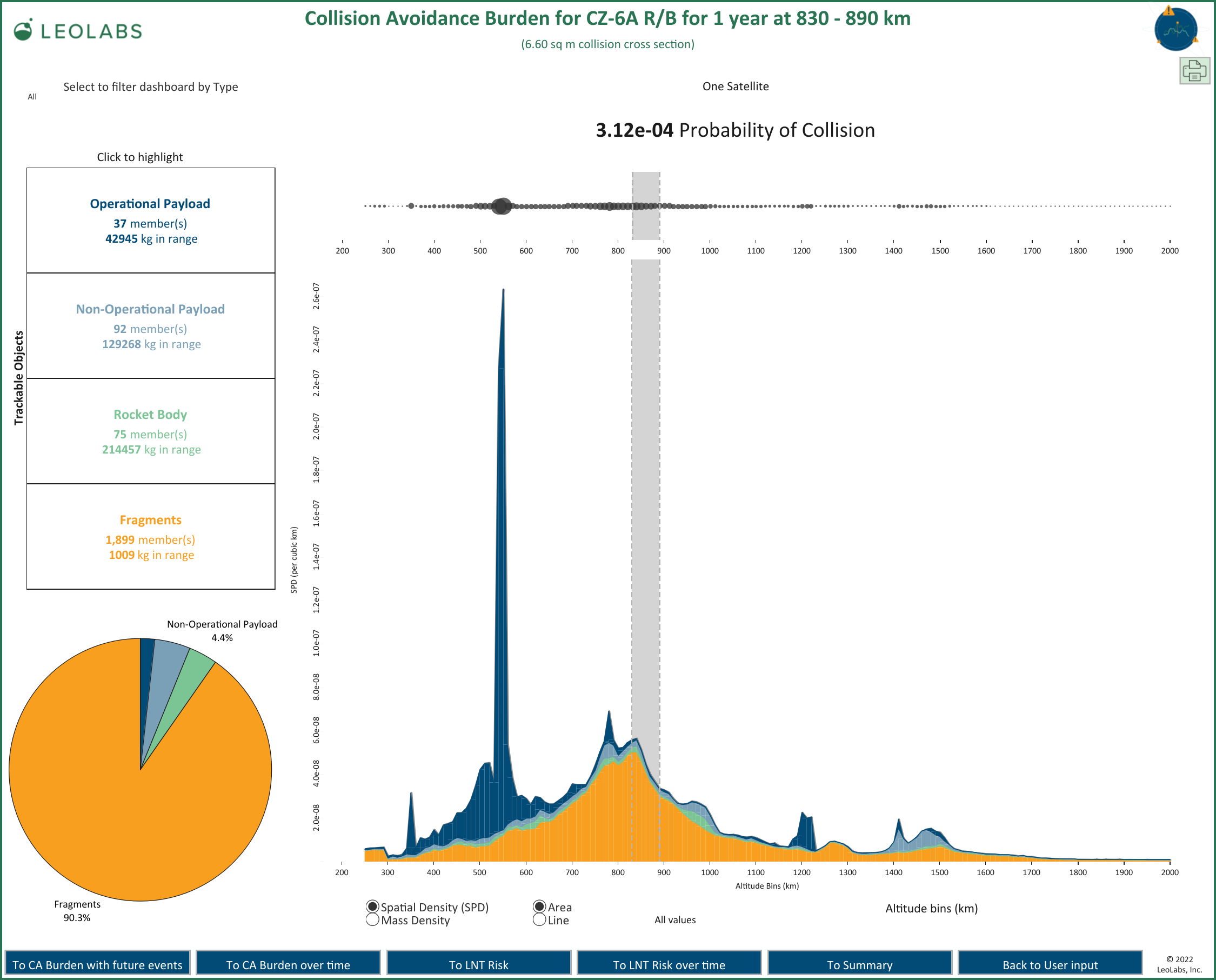
We hypothesize that the explosion may have been triggered by an attempt to vent remaining propellants, an attempt at an orbit-lowering burn, or the rocket stage simply failed to shut down smoothly. The potential of the incident being propulsion-related is reinforced by reporting from astronomer Cees Bassa, who stated in a video by Dan Bush of Missouri Skies that “observations from two consecutive passes over the US in the hours after launch show fuel leaking from the rocket.” Other energy sources on the rocket body likely include batteries and pressurized vessels related to the propulsion system.
“We hypothesize that the [CZ-6A] explosion may have been triggered by an attempt to vent remaining propellants, an attempt at an orbit-lowering burn, or the rocket stage simply failed to shut down smoothly.”
To further understand this event, we’ve illustrated the resulting fragment cloud in a Gabbard diagram and a spike plot. The Gabbard diagram for the CZ-6A rocket body, shown below, illustrates the distribution of objects in LEO from as low as ~320 km to as high as ~1,500 km.
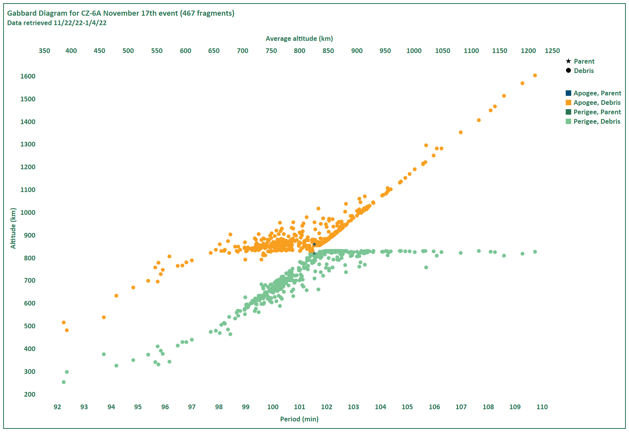
The spike plot, shown below, plots the spatial density of the fragment cloud as a function of altitude. This provides an immediate measure of the collision risk posed to other resident space objects from a breakup event. The peak and average spatial density values can be compared to the existing background population levels at these altitudes. With the CZ-6A explosion, for example, we see that the spatial density at 830 km before the event was 5.6E-8, whereas the fragment cloud from the CZ-6A rocket body peaks at 5.0E-9. As a result, the collision probability at 830 km rose by around 9%. This percentage increase drops rapidly to less than 2% in the region below 700 km and above 900 km.
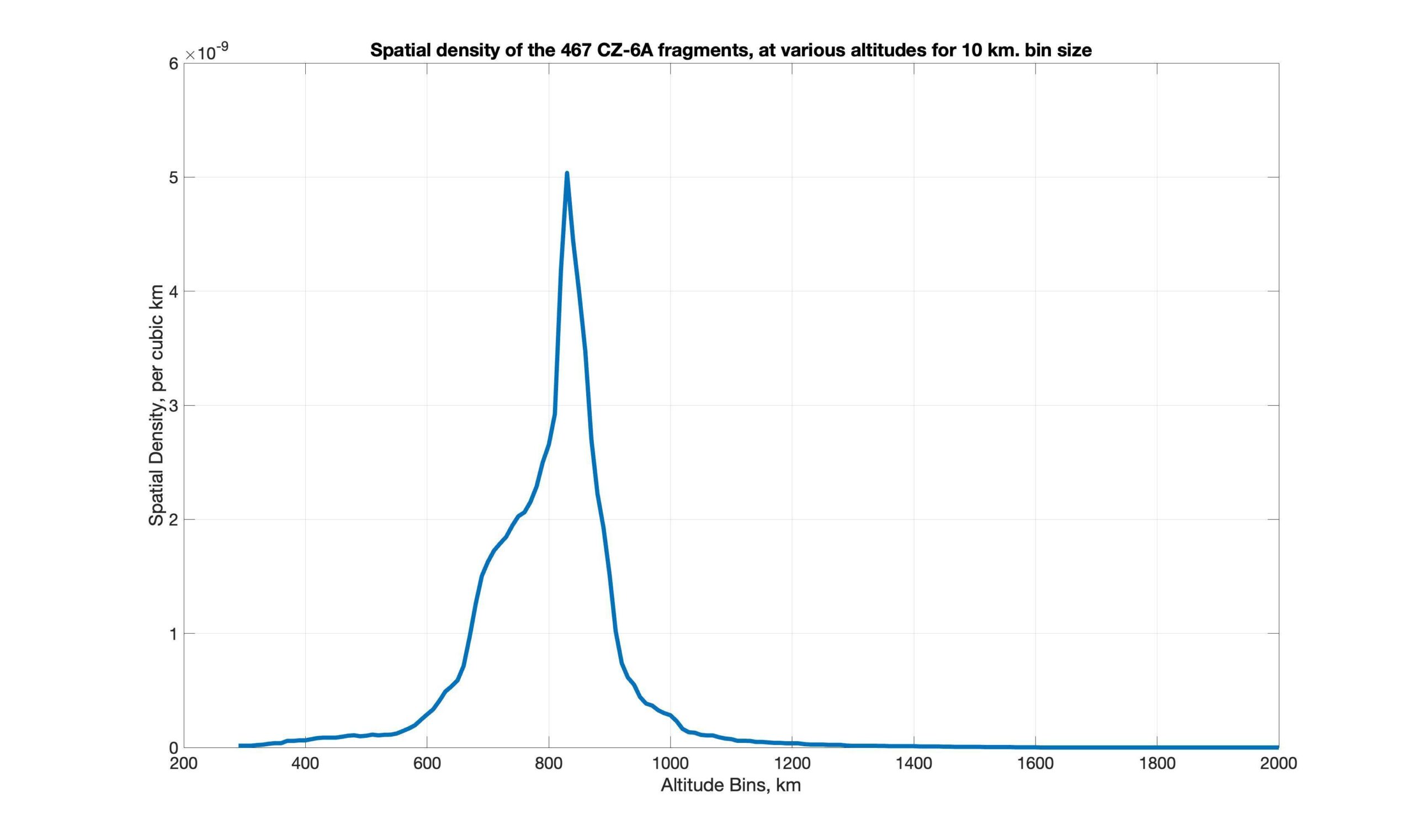
By 31 December 2022, we reported 772 conjunctions with a probability of collision (PC) greater than 1E-6 involving a fragment from this event. These events occurred between 345 km and 1,441 km in altitude. The number of conjunctions with a PC greater than 1E-5 and 1E-4 were 44 and 4, respectively.
This figure from LeoLabs’ mapping tool shows the distribution of conjunction events as a function of time and type of object with which the CZ-6 fragments were conjuncting. Based on our analysis, over a third of the events involved an operational payload and around 12% involved derelict rocket bodies. Of the 94 events involving these derelict rocket bodies, 20 involved massive SL-16 rocket bodies, which are considered the most problematic dead objects in LEO and therefore the most important to remove through Active Debris Removal. (Learn more about the clusters of SL-16 rocket bodies in our previous report.)

Our team at LeoLabs will continue to monitor and characterize the collision risk resulting from the CZ-6A’s fragment cloud, which includes issuing Conjunction Data Messages and assessing the most dangerous encounters in LEO involving these objects.
Key takeaways:
- Two notable events contributed to collision hazard from debris clouds: the on-orbit anti-satellite weapons test conducted by Russia in November 2021 and the CZ-6A rocket body explosion in November 2022
- The CZ-6A explosion occurred in the “bad neighborhood” of 800 km to 900 km; the collision probability from these fragments increased by 9% at the center of the cloud at 830 km

Constellations of operational payloads
Enough about space debris, let’s talk about constellations. While SpaceX’s Starlink has captured the public’s imagination due to its rapid growth (they added ~1,500 payloads in 2022!) several other constellations also grew significantly. These include OneWeb, Planet, Swarm, and Spire Global, which all had double digit percentage growth rates last year. This makes for an exciting — and increasingly dynamic — commercial environment in LEO.
Of course, this growth in operational payloads presents challenges that make space traffic coordination increasingly critical. This is evident in the changing proportion of high probability conjunctions (i.e., PC > 1E-6). In particular, we’ve observed an increase in Space Traffic Management (STM) conjunctions relative to Space Debris Management (SDM) conjunctions. A STM conjunction is any close approach that includes at least one operational payload, while a SDM conjunction is between two dead objects. On average in 2022, there were twice as many STM events as SDM events, but that’s not the whole story.
“It’s becoming more critical for [satellite operators] to procure advanced collision avoidance services and share data related to their satellites’ position in space.”
Interestingly, earlier in the year, the proportion of events was 40% SDM and 60% STM. By the end of the year, however, this proportion changed significantly to 80% STM and 20% SDM. Why does this matter? This indicates an increase in high-PC events involving satellite operators, which means it’s becoming more critical for them to procure advanced collision avoidance services and share data related to their satellites’ position in space.
Key takeaways:
- Several companies experienced double digit constellation growth rates in LEO in 2022
- We observed two times as many Space Traffic Management (STM) conjunctions relative to Space Debris Management (SDM) conjunctions: earlier in the year the proportion was 40% SDM and 60% STM but this flipped by the end of the year to 80% STM and 20% SDM

Kept your eye on the sky? Other updates you may have missed
Now that we’ve covered the action in orbit, let’s cover the action on Earth — specifically three major policy advancements regarding space safety.
In September 2022, the Federal Communications Commission (FCC) adopted a new 5-year rule, which requires satellite licensees to remove their payloads from orbit within five years after the end of their mission lifetime. This is a significant reduction of the previous 25-year rule. Our team at LeoLabs supported this change due to the growing risks posed by space debris in LEO. (For example, NASA recently cancelled a spacewalk due to the threat of space debris hitting the International Space Station.) This rule change is indicative of national and international entities finally understanding that enhancing space safety in LEO requires leaving less debris in orbit.
Similarly, the United States (US) spearheaded a call for a global moratorium on destructive, on-orbit ASAT testing. In mid-December, the United Nations General Assembly (UNGA) adopted a resolution introduced by the US, with 155 nations voting in favor, nine voting against, and nine abstaining. This initiative reflects the growing concern over the effects from ASAT tests: fragments from the last two on-orbit ASAT tests (i.e., Fengyun 1C and Cosmos 1408) contributing significantly to collision risk in LEO. As we’ve reported previously, more than 25% of all high-PC conjunctions in LEO in 2022 involved a fragment from these tests.
Finally, US Senator John Hickenlooper and his staff rallied a bipartisan initiative that became the Orbital Sustainability Act, which the US Senate unanimously passed in 2022. This Act seeks to operationalize Active Debris Removal (ADR) on massive derelict objects that have been left in orbit by previous US Government space missions. It’s exciting to see the US commit to remediate some of the mass in LEO that poses significant debris-generating potential.
In addition to the policies above, this past year was characterized by a growing concern regarding uncontrolled reentries of space objects, specifically rocket bodies, which pose a risk to the environment and human life. In response, the Outer Space Institute published an international open letter calling for “reducing risks from uncontrolled reentries of rocket bodies.” This letter, published on 19 December 2022, addressed space agency leaders in the US, China, Canada, Russia, Japan, India, and Europe. Both LeoLabs Senior Technical Fellow Dr Darren McKnight (co-author of this report) and LeoLabs Australia President Terry van Haren are signatories.
One last thing…
Before we wrap up this special edition of LeoPulse, let’s briefly return to the numbers. (We are the LeoLabs data team after all; numbers are kind of our thing!)
As stated in the introduction, there was a net increase of ~2,500 objects in LEO in 2022, that’s four times higher than in the last 15 years. This growth also occurred at a rate ~13 times faster than during the first 50 years of the Space Age. The number of objects is just part of the story, however. Mass accumulation is also an important component in understanding future debris-generating potential. (For more information, read our guide to calculating collision risk.)
“There was a net increase of ~2,500 objects in LEO in 2022, that’s four times higher than in the last 15 years. This growth also occurred at a rate ~13 times faster than during the first 50 years of the Space Age.”
The time-sequence video below starts from the beginning of the Space Age — around 1957, when the Soviet Union launched Sputnik — and ends in 2022. The left panel depicts the number of intact objects (such as operational payloads, non-operational payloads, and rocket bodies) deposited at each altitude annually. The panel on the right depicts the accumulation of mass for each of these three object categories over time.
From this illustration, we’ve drawn three major observations:
- The drastic increase in operational payloads since 2020 is transformational and not expected to slow down soon
- Despite the exponential increase in the number of operational payloads, their total mass is still less than the accumulated mass of intact derelicts (i.e., rocket bodies and non-operational payloads); these large derelicts are likely to be a catalyst for future debris-generating events
- Rocket bodies and non-operational payloads abandoned early in the Space Age (before the turn of the century) at certain orbits (now called “clusters”) are persistent and account for most of the derelict mass in LEO
— Return to: Clusters | Clouds | Constellations —
More of a visual learner? We’ve got you covered. Download this infographic.
And that’s all for now folks!
Stay tuned for the 5th edition of LeoPulse coming out in mid-February which will feature a thought leadership piece from our team. If you haven’t signed up for our newsletter yet, please do so you don’t miss the next edition. Want more content like this right now? Check out the previous editions of LeoPulse. We suggest starting with LeoLabs CEO Dan Ceperley’s guide to potential disasters in LEO.
Ad astra!
Note: The findings shared in this report and infographic are derived from the hundreds of thousands of data products LeoLabs’ global network of phased array radars collects daily.
